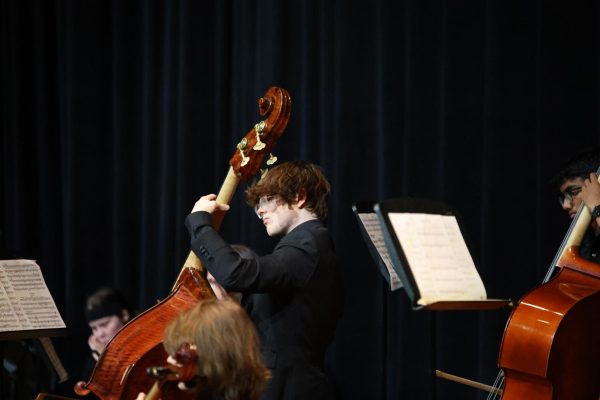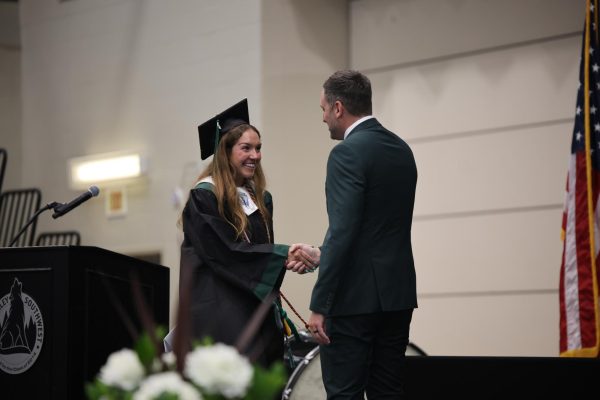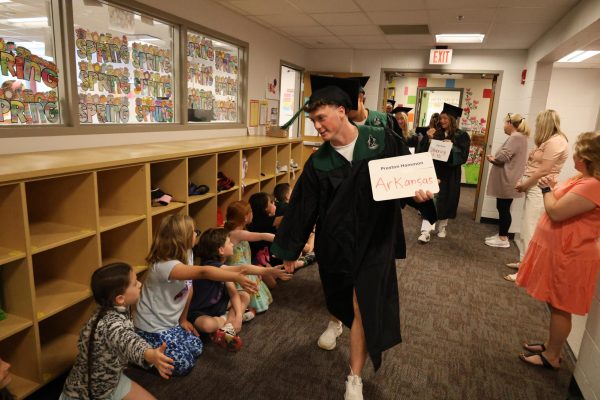Students enroll in courses at Olathe Advanced Technical Center
In the facility, students learn real-life work skills in an environment that mirrors that of the workplace. They learn automotive repair, aspects of construction and culinary skills. But these students do not go to CAPS: they attend the Olathe Advanced Technical Center.
The Olathe Advanced Technical Center (OATC) is part of the Olathe school district, but also provides services to students from Blue Valley, DeSoto, Spring Hill, and Wellsville.
Senior Justin Patterson began taking the Automotive Technologies I class this year. His goal is to learn how to service his car himself and not to pay others to do it. However, he may not have known the class existed.
“This whole program is not advertised at Blue Valley,” Patterson said. “I heard it from Seth Thomas who was on the basketball team last year, so if I had not talked to him, I would not have done it. That’s probably why there aren’t many Blue Valley kids doing it; many haven’t even heard about it.”
Director for Career and Technical Education Linda Affholder said Blue Valley FACS and drafting teachers visit the technical centers so they can recommend it to students who would be interested.
Students submit applications for the program and are chosen based on the number of seats available at the center. To reduce the number of applicants, only juniors and seniors are allowed into the program and seniors are typically given priority.
“There are limited numbers of people in these classes, like there are already too many people in my class now,” Patterson said. “That will be interesting in a few years if they advertise it more and [OATC] went multiple years having to turn down Blue Valley students to this program, then Blue Valley might want to think about doing it… it might be a problem, but it would be a good problem.”
In the OATC automotive classes, the students have time in classrooms to listen to instructors, and also hands-on time to work on the vehicles and get first-hand experience with car maintenance and repairs.
Patterson said he has learned about “suspension in cars, taking out all the springs, and about what makes the car stay on the road, tearing it apart and putting it back together, and how to diagnose problems.”
The first-hand experience gained by the students helps prepare them to perform tasks a mechanic would be asked to do.
“It teaches you a lot about actually working, because they will give you tasks you have to complete,” senior Garrison Louis said.
Louis has taken classes at OATC during both his junior and senior year. He was placed in Automotive Technologies II last year, but wanted to complete the series and took Auto I this year. He said he has found this class has been very helpful to him not only because of the skills he has gained, but also because of the opportunities available at OATC during open lab time.
“I actually had something last year where I had [my car] taken to a shop to see how much they would charge and it was going to be $500,” Louis said. “It was a little hose behind the motor. I was able to do it for fifteen bucks. So you can save money, and they provide a lot of tools. It is a nice facility; it is a brand-new shop. I’ve seen kids do several thousand dollar projects for a couple hundred bucks.”
OATC also recently moved from its original location to a new building with more space for the classes and tools.
“At Olathe, the facilities are top-notch,” Patterson said. “I heard the professionals will come in and tour the center and say that the facilities are kept nicer than their shop is, and they’re from O’Reilly, or some other auto shop.”
For the students in these classes who are planning on going into the mechanical field, job opportunities are promising. The center often receives job offers from corporations and works to match students with these offers.
“Salaries in this field are exceptional, especially in today’s economy,” automotive instructor Ken Gandy said. “You can make anywhere from 40 to over 100 thousand dollars a year as a technician depending on your skill level. It’s not the dirty slimy work it used to be. It’s much more technical, much more advanced.”
As well as earning high salaries, students pursuing the mechanical field have insurance that their jobs will be there.
“It’s a very applicable field,” Gandy said. “People are still driving and things are still breaking.”
The center is unique because of the opportunities it provides. Students can take a test at the end of the year that is the educational equivalent of the ASE, or Automotive Service Excellence, Certification, which most mechanics are required to have. Or, students can take the hours and apply them toward college.
“It’s the training that makes the difference,” Gandy said. “What we do is provide a national-based training. Our curriculum matches Johnson County’s, and for that reason, we offer College Now, so students can leave here with 15 college credits paid for by the state. They can take those anywhere, or they can do an outstanding deal with Johnson County which is 17 hours. We’re the only school that I know of in the state that does that. We figured it saves the student over 2,000 dollars on tuition.”
To enroll in the OATC programs, a student has to be ready for the extra accountability that comes with the class.
“The student really has to be responsible,” Affholder said. “They have to provide their own transportation and get there on time as well as return on time if they have classes after. Field trips and finals schedules can also be a challenge because [Olathe’s] finals are not the same as ours, and the student has to make sure they are meeting the requirements for the courses.”
However, Gandy finds the program worthwhile.
“Our philosophy is that once they’re here, they’re part of OATC, not part of their home school,” Gandy said. “This is where you are at: you’re an OATC student. We try to build a family atmosphere from that so the students buy in. We’ve had success with that: students will tell you they go to OATC.”

Lillie Hoffart is a senior and has been on staff since her freshman year. She enjoys writing and designing for the paper and is the managing editor....









